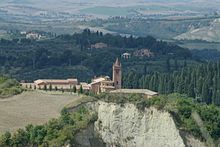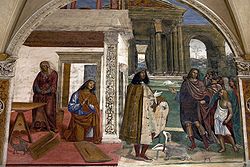- Territorial Abbey of Monte Oliveto Maggiore
-
Territorial Abbey of Monte Oliveto Maggiore
Abbatia Territorialis Sanctae Mariae Montis Oliveti Maioris
CathedralLocation Country Italy Metropolitan Immediately subject to the Holy See Statistics Area 49 km2 (19 sq mi) Population
- Total
- Catholics(as of 2004)
500
500 (100%)Information Rite Latin Rite Cathedral Abbazia di Monte Oliveto Maggiore Current leadership Bishop Diego Gualtiero Maria Rosa, O.S.B. The Abbey of Monte Oliveto Maggiore is a large Benedictine monastery in the Italian region of Tuscany, 10 km south of Asciano. Its buildings, which are mostly of red brick, are conspicuous against the grey clayey and sandy soil—the Crete senesi which give this area of Tuscany its name.
It is a territorial abbey whose abbot functions as the bishop of the land within the abbey's possession, even though he is not consecrated as a bishop.
It is the mother-house of the Olivetans and the monastery later took the name of Monte Oliveto Maggiore ("the greater") to distinguish it from successive foundations at Florence, San Gimignano, Naples and elsewhere.
Contents
History
It was founded in 1313 by Bernardo Tolomei, a jurist from one of the most outstanding families in Siena. In 1319 or 1320 it was approved by Bishop Guido Tarlati as Monte Oliveto, with reference to the Mount of Olives and in honour of Christ’s Passion. The monastery was begun in 1320, the new congregation being approved by Pope Clement VI in 1344.
The abbey was for centuries one of the main land possessors in the Siena region.
On January 18, 1765, the monastery was made the seat of the Territorial Abbacy of Monte Oliveto Maggiore.
Leadership
- Territorial Abbots of Monte Oliveto Maggiore (Roman rite)
- Abbot Diego Gualtiero Rosa O.S.B (2010.10.18 - present)
- Abbot Michelangelo Riccardo M. Tiribilli, O.S.B. (1992.10.16 – 2010.10.18)
- Abbot Maurizio Benvenuto Maria Contorni, O.S.B. (1986.11.29 – 1992)
- Abbot Divo Angelo Maria Sabatini, O.S.B. (1970.12.05 – 1986)
- Abbot Pietro Romualdo M. Zilianti, O.S.B. (1947.05.10 – 1970)
- Abbot Luigi Maria Perego, O.S.B. (1928.10.15 – 1946)
- Abbot Mauro M. Parodi, O.S.B. (1917.09.10 – 1928)
- Abbot Ildebrando Polliuti, O.S.B. (1899.01.08 – 1917.09.10)
Overview
Interior
The monastery is accessed through a drawbridge which leads to a medieval palace in red brickwork, surmounted by a massive quadrangular tower with barbicans and merlons. This edifice was begun in 1393 as the fortified gate of the complex; it was completed in 1526 and restored in the 19th century. Over the entrance arch is a terracotta depicting Madonna with Child and Two Angels attributed to the Della Robbia family, as well as the St. Benedict Blessing nearby.
After the entrance structure is a long alley with cypresses, sided by the botanical garden of the old pharmacy (destroyed in 1896) a water collector pool from 1533. At the alley's end is the bell tower, in Romanesque-Gothic style, and the apse of the church, which has a Gothic façade.
Chiostro Grande
The Chiostro Grande ("Great Cloister") has a rectangular plan and was realized between 1426 and 1443. On the oldest side it has a two-storey loggia and a pit, dating to 1439. Under the vaults of the cloister are frescoes of the Life of St. Benedict painted by Luca Signorelli and il Sodoma, considered amongst the most important Renaissance artworks in Italy.
The frescoes disposition follows St. Gregory's account of Benedict's life. Signorelli's paintings were executed in 1497-98, while Sodoma's date to 1505 afterwards.
The church
The church entrance is preceded, in the Chiostro Grande, by a frescoes with Jesus Carrying the Cross, Jesus at the Column and St. Benedict Giving the Rule to the Founders of Monte Oliveto, also by Sodoma. The church's atrium is on the site of a previous church (1319), showing on the walls ferscoes with Father Hermits in the Desert and St. Benedict's miracle, both by an unknown Seines artist. In a niche is the "Madonna with Child Enthroned" by Fra Giovanni da Verona.
The church as nave on the Latin cross plan, with a luminous interior. It was renovated in Baroque style in 1772 by Giovanni Antiori. The main attraction is the wooden inlaid choir by Giovanni da Verona, executed in 1503-1505. It is one of the most outstanding examples of tarsias in Europe. The church houses also a canvas by Jacopo Ligozzi (Assumtpion, 1598), behind the high altar, and a 14th century polychrome wooden Crucifix, in the Sacrament Chapel. The sacristy has an inlaid ceiling dating to 1417.
Chiostro di Mezzo
Che Chiostro di Mezzo ("Middle Cloister") was built in the 15th century, surrounded by a portico with octagonal pilasters. Artworks include a 15th century Madonna with Child and Angels and Annunciation by Riccio. Nearby is the entrance to the refectory, decorated by frescoes by Fra Paolo Novelli (1670) and, in the end wall, a canvas of the Last Supper by Lino Dinetto (1948).
Library and Pharmacy
The stairs leading to the first floor are decorated by Sodoma's fresco depicting the Coronation of Mary and one by an unknown artist of the Deposition. Antonio Muller (an artist from Danzig) executed in 1631 a Characters and Events of the Olivetani, while by Giovanni da Verona is a wooden candelabrum (1502). The latter artist was also author of the library, which has a basilica plan with a nave and two aisles divided by columns with Corinthian capitals (1518). Nearby is the Monastic Library, housing some 40,000 volumes and incunabula. From the library is the access to the Pharmacy, housing, in 17th century vases, a collection of medicinal herbs.
Definitorio
The name Definitorio refers to the Capitular Hall (1498), on whose end wall is a fresco of Madonna with Child and Saints by Matteo Ripanda (16th century); the hall houses a small museum of Sacred Arts, with works by Segna di Bonaventura (Madonna with Child), the Master of Monte Oliveto (Maestà), Neroccio di Bartolomeo (St. Bernardino), Vincenzo Tamagni (Madonna with Child) and a fresco portraying St. Sebastian by an artist of the Sienese School.
References
 This article incorporates text from a publication now in the public domain: Chisholm, Hugh, ed (1911). Encyclopædia Britannica (11th ed.). Cambridge University Press.
This article incorporates text from a publication now in the public domain: Chisholm, Hugh, ed (1911). Encyclopædia Britannica (11th ed.). Cambridge University Press.External links
- Official website (Italian) (English)
- The Monte Oliveto Maggiore Museum (Italian) (English)
- Abbazia di Monte Oliveto Maggiore (English)
- Adrian Fletcher’s Paradoxplace – Monte Oliveto Maggiore Photos and History Page
- Giga-Catholic Information
- Catholic Hierarchy
- Abbey Website
Coordinates: 43°10′31″N 11°32′39″E / 43.17528°N 11.54417°E
Categories:- Benedictine monasteries in Italy
- Monasteries in Tuscany
- Crete Senesi
- Religious organizations established in the 1310s
- Renaissance paintings
- Roman Catholic dioceses in Italy
- Christian monasteries established in the 14th century
- Christian organizations established in the 14th century
- Territorial Abbots of Monte Oliveto Maggiore (Roman rite)
Wikimedia Foundation. 2010.



